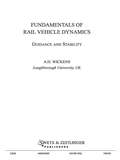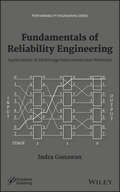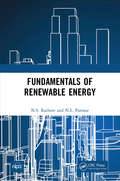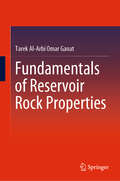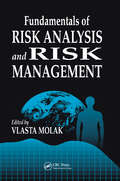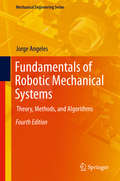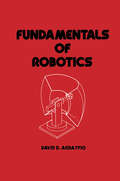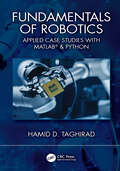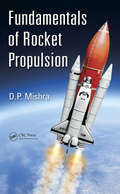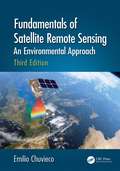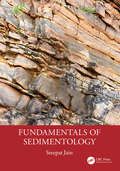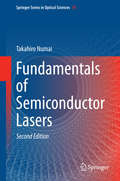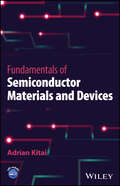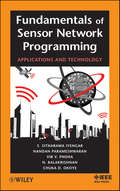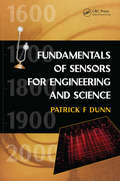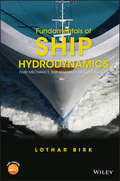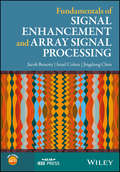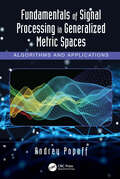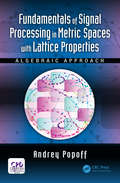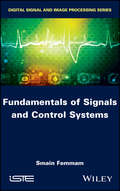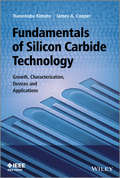- Table View
- List View
Fundamentals of Rail Vehicle Dynamics: Guidance And Stability
by Alan WickensFundamentals of Rail Vehicle Dynamics lays a foundation for the design of rail vehicles based on the mechanics of wheel-rail interaction as described by the equations of motion. The author advances simple models to elucidate particular challenges and demonstrate innovative systems while using analytical studies to examine novel design concepts. Rather than focusing on a "typical" set of parameters, the book discusses the issues associated with the complete range of parameters available, concentrating on the configuration and parametric design of the bogie in relation to steering, dynamic response, and stability. This is an excellent reference for designers and researchers involved vehicle development.
Fundamentals of Railway Design (Springer Tracts in Civil Engineering)
by Marco GuerrieriThis textbook examines key railway engineering topics useful for railway design and control. Conventional railways are considered together with high-speed railways, tramways, metros, maglev and hyperloop systems, people movers, monorails and rack railways. Every system of transport is described in its basic technical characteristics, especially in terms of transportation system capacity, alignment design criteria and construction costs. It is an introductory book to specific topics of the railway engineering field, and thus, the mathematical treatment is purposely brief and simplified. The book is an ideal learning resource for students of civil engineering, as well as a valuable reference for practicing engineers involved with railway designs.
Fundamentals of Reaction Flowmeters
by Horia Mihai MoțitThis book is the first one that presents both the new elaborated method of the flow measurement, named by the author the "Flow Measurement Based on Reaction Force", including its specific "reaction measurement system", which ensures its practical implementation, and the new basic types of flowmeters, configured according to it, named "reaction flowmeters". These achievements were the result of the first implementation, in the last two years, of the Unitary Synthesis and Design Method of Flowmeters (European Patent EN the 3364159, granted in 2020). Due to its universality and flexibility, the "Flow Measurement Based on Reaction Force" keeps the same configuration of the reaction measurement system for the design of any new basic types of reaction flowmeters. The book presents the reaction flowmeters by following the logical sequence of their structural (implicitly functioning) evolution, which rendered the logical systematic way followed for their configuration. The book details successively (main analytical, constructive, and functional features) the individual (single) reaction flowmeters, configured both without and with moving parts, respectively, the specific connections of two single reaction flowmeters, named "extended reaction flowmeters" and the bypass type reaction flowmeters. All of these flowmeters can be used for both liquids and gases. Presenting the practical results and using the knowledge of the unitary bases of the flowmeters, identified by the previous book, Unitary Analysis, Synthesis, and Classification of Flow Meters (2018), this new publication is written for all specialists in the field of flow measurement and instrumentation, and especially for flowmeters manufacturers and R&D specialists, in addition to the teaching staff and students at such specialized, technical, and high-level universities. The book is also an efficient tool for predictable design of new types of reaction flowmeters, by following the logical steps (questions) already taken in the configuration of the reaction flowmeters presented, and by diversifying with new answers given to them.
Fundamentals of Reliability Engineering: Applications in Multistage Interconnection Networks
by Indra GunawanThis book presents fundamentals of reliability engineering with its applications in evaluating reliability of multistage interconnection networks. In the first part of the book, it introduces the concept of reliability engineering, elements of probability theory, probability distributions, availability and data analysis. The second part of the book provides an overview of parallel/distributed computing, network design considerations, and more. The book covers a comprehensive reliability engineering methods and its practical aspects in the interconnection network systems. Students, engineers, researchers, managers will find this book as a valuable reference source.
Fundamentals of Renewable Energy
by N.S. Rathore N.L. PanwarThis book is to provide in-depth information on fundamentals of different renewable energy resources. The primary emphasis is on fundamentals of thermodynamics and heat transfer aspects of renewable energy gadgets and their actual applications. Various renewable energy systems are described and their fundamental analyses are described.Note: T&F does not sell or distribute the hardback in India, Pakistan, Nepal, Bhutan, Bangladesh and Sri Lanka. This title is co-published with NIPA.
Fundamentals of Reservoir Rock Properties
by Tarek Al-Arbi GanatThis book explains the basic technologies, concepts, approaches, and terms used in relation to reservoir rocks. Accessible to engineers in varying roles, it provides the tools necessary for building reservoir characterization and simulation models that improve resource definition and recovery, even in complex depositional environments.The book is enriched with numerous examples from a wide variety of applications, to help readers understand the topics. It also describes in detail the key relationships between the different rock properties and their variables. As such, it is of interest to researchers, engineers, lab technicians, and postgraduate students in the field of petroleum engineering.
Fundamentals of Residential Construction
by Edward Allen Rob Thallon Alexander C. SchreyerFUNDAMENTALS OF RESIDENTIAL CONSTRUCTION THE NEW EDITION OF THE DEFINITIVE GUIDE TO PROFESSIONAL HOME CONSTRUCTION, FULLY UPDATED AND REVISED Fundamentals of Residential Construction provides clear, accurate, and accessible guidance to every step of single family and multifamily home construction, covering site preparation, project delivery methods, scheduling, foundations, framing, roofing, finishes, heating and cooling, plumbing and electrical, as well as emerging techniques such as prefabricated construction. Illustrated with more than 1,250 high-quality drawings, photographs, and photorealistic renderings throughout, this thorough textbook addresses all major construction systems: light wood frame, heavy timber, masonry, light gauge steel, steel frame, reinforced concrete construction, and outdoor structures. The fifth edition is thoroughly revised to reflect the industry’s latest methods, materials, technologies, and green building approaches, offering the most up-to-date explanations of today’s residential construction systems and current building codes, including the International Residential Code (IRC) and energy codes. This edition features entirely new materials sections on metals, plastics, and composite construction as well as expanded and updated content on ventilation, air-sealing, decks, and outdoor structures. Provides a solid foundation in residential construction methods, tools, and processes Discusses the latest codes, costs, trends, and best practices in design and construction Offers timely coverage of sustainable building, energy efficiency, multifamily construction, prefabricated building components, CAD/BIM planning tools, and carbon-conscious construction Includes access to a newly updated companion website with an instructor’s manual, chapter exercises, hands-on 3D interactive activities, and other supplementary resources Fundamentals of Residential Construction, Fifth Edition, remains essential reading for anyone looking to successfully complete a residential project. It is a perfect textbook for students in architecture, construction science, construction management, and building technology, and is a valuable reference for professional builders, construction managers, and designers.
Fundamentals of Risk Analysis and Risk Management
by Vlasta MolakThis book bridges the gap between the many different disciplines used in applications of risk analysis to real world problems. Contributed by some of the world's leading experts, it creates a common information base and language for all risk analysis practitioners, risk managers, and decision makers.Valuable as both a reference for practitioners and a comprehensive textbook for students, Fundamentals of Risk Analysis and Risk Management is a unique contribution to the field. Its broad coverage ranges from basic theory of risk analysis to practical applications, risk perception, legal and political issues, and risk management.
Fundamentals of Robotic Mechanical Systems
by Jorge AngelesThe 4th edition includes updated and additional examples and exercises on the core fundamental concepts of mechanics, robots, and kinematics of serial robots. New images of CAD models and physical robots help to motivate concepts being introduced. Each chapter of the book can be read independently of others as it addresses a seperate issue in robotics.
Fundamentals of Robotics
by David ArdayfioFundamentals of Robotics presents the basic concepts of robots to engineering and technology students and to practicing engineers who want to grasp the fundamentals in the growing field of robotics.
Fundamentals of Robotics: Applied Case Studies with MATLAB® & Python
by Hamid D. TaghiradIn an era where robotics is reshaping industries and redefining possibilities, "Fundamentals of Robotics: Applied Case Studies with MATLAB® & Python" emerges as an essential guide for both aspiring engineers and seasoned professionals. This comprehensive book bridges the gap between theoretical knowledge and practical application, driving advancements in robotics technology that mimic the complexity and grace of biological creatures.Explore the intricate world of serial robots, from their kinematic and dynamic foundations to advanced control systems. Discover how the precise movements of a magician's fingers or the poised posture of a king cobra inspire the mathematical principles that govern robotic motion. The book delves into the Denavit-Hartenberg method, screw theory, and the Jacobian matrix, providing a thorough understanding of robot design and analysis.Unique to this text is the integration of MATLAB® and Python, offering readers practical experience through step-by-step solutions and ready-to-use code. Each chapter is enriched with real-world case studies, including the 6-DOF Stanford robot and the Fanuc S-900w, allowing readers to apply theoretical concepts to tangible problems. The inclusion of biological examples enhances the relevance and accessibility of complex topics, illustrating the natural elegance of robotics.Key Features: Includes a diverse range of examples and exercises with accompanying MATLAB® and Python codes. Contains over 30 case studies which allows the readers to gain a thorough understanding. Aids instruction in classrooms with inclusion of teaching slides and handouts. Combines diverse topics like kinematics, dynamics, and control within a single book. Ideal for senior undergraduate and graduate students, as well as industry professionals, this book covers a wide range of topics, including linear and nonlinear control methods, trajectory planning, and force control. The dynamic models and control strategies discussed are crucial for anyone involved in the design, operation, or study of industrial robots."Fundamentals of Robotics: Applied Case Studies with MATLAB® & Python" is more than a textbook; it is a vital resource that provides the knowledge and tools needed to succeed in the dynamic field of robotics. Join the journey towards mastering robotic technology and contribute to the future of intelligent machines.
Fundamentals of Rocket Propulsion
by D. P. Mishra<p>The book follows a unified approach to present the basic principles of rocket propulsion in concise and lucid form. This textbook comprises of ten chapters ranging from brief introduction and elements of rocket propulsion, aerothermodynamics to solid, liquid and hybrid propellant rocket engines with chapter on electrical propulsion. Worked out examples are also provided at the end of chapter for understanding uncertainty analysis. <p>This book is designed and developed as an introductory text on the fundamental aspects of rocket propulsion for both undergraduate and graduate students. It is also aimed towards practicing engineers in the field of space engineering. This comprehensive guide also provides adequate problems for audience to understand intricate aspects of rocket propulsion enabling them to design and develop rocket engines for peaceful purposes.</p>
Fundamentals of Satellite Remote Sensing: An Environmental Approach, Third Edition
by Emilio ChuviecoFundamentals of Satellite Remote Sensing: An Environmental Approach, Third Edition, is a definitive guide to remote sensing systems that focuses on satellite-based remote sensing tools and methods for space-based Earth observation (EO). It presents the advantages of using remote sensing data for studying and monitoring the planet, and emphasizes concepts that make the best use of satellite data. The book begins with an introduction to the basic processes that ensure the acquisition of space-borne imagery, and provides an overview of the main satellite observation systems. It then describes visual and digital image analysis, highlights various interpretation techniques, and outlines their applications to science and management. The latter part of the book covers the integration of remote sensing with Geographic Information System (GIS) for environmental analysis. This latest edition has been written to reflect a global audience and covers the most recent advances incorporated since the publication of the previous book, relating to the acquisition and interpretation of remotely sensed data. New in the Third Edition: Includes additional illustrations in full color. Uses sample images acquired from different ecosystems at different spatial resolutions to illustrate different interpretation techniques. Includes updated EO missions, such as the third generations of geostationary meteorological satellites, the new polar orbiting platforms (Suomi), the ESA Sentinels program, and high-resolution commercial systems. Includes extended coverage of radar and LIDAR processing methods. Includes all new information on near-ground missions, including unmanned aerial vehicles (UAVs). Covers new ground sensors, as well as machine-learning approaches to classification. Adds more focus on land surface characterization, time series, change detection, and ecosystem processes. Extends the interactions of EO data and GIS that cover different environmental problems, with particular relevance to global observation. Fundamentals of Satellite Remote Sensing: An Environmental Approach, Third Edition, details the tools that provide global, recurrent, and comprehensive views of the processes affecting the Earth. As one of CRC’s Essential titles, this book and stands out as one of the best in its field and is a must-have for researchers, academics, students, and professionals involved in the field of environmental science, as well as for libraries developing collections on the forefront of this industry.
Fundamentals of Sedimentology
by Sreepat JainThis new textbook is a modern look at key concepts of sedimentology. With lavish, colorful, and abundant illustrations and easy-to-understand explanations, the book focuses on the concepts required to understand physical, chemical, and biological characteristics of sedimentary rocks and the processes involved in their formation. This includes the transportation, deposition, and transformation of sediments. It also emphasizes how the understanding of sedimentary rocks can be used to interpret all continental, marginal marine, and deep-water oceanic environments. Written with undergraduate-level students in mind, it serves as a primary textbook for the new generation of students.Features Fully up-to-date coverage, using the latest studies in the field of sedimentology. Many colorful illustrations to facilitate the understanding of key concepts. Explanations that are jargon-free and easy to understand for the undergraduate-level reader. Examples to interpret ancient environmental conditions in sediment source areas and depositional sites Written by an experienced researcher and academic who has taught the course at different universities and countries for over 20 years, Fundamentals of Sedimentology is an excellent resource for upper-level undergraduate and graduate students studying Geology, Geomorphology, Physical Geology, and Geography, and it serves as a great reference for entry-level researchers who work in the same fields.
Fundamentals of Semiconductor Lasers
by Takahiro NumaiThis book explains physics under the operating principles of semiconductor lasers in detail based on the experience of the author, dealing with the first manufacturing of phase-shifted DFB-LDs and recent research on transverse modes. The book also bridges a wide gap between journal papers and textbooks, requiring only an undergraduate-level knowledge of electromagnetism and quantum mechanics, and helps readers to understand journal papers where definitions of some technical terms vary, depending on the paper. Two definitions of the photon density in the rate equations and two definitions of the phase-shift in the phase-shifted DFB-LD are explained, and differences in the calculated results are indicated, depending on the definitions. Readers can understand the physics of semiconductor lasers and analytical tools for Fabry-Perot LDs, DFB-LDs, and VCSELs and will be stimulated to develop semiconductor lasers themselves.
Fundamentals of Semiconductor Materials and Devices
by Adrian KitaiGain an introduction to the concepts behind semiconductor materials and devices in this advanced textbook Semiconductors are the foundation of the electronics industry, and are therefore embedded in virtually all modern technology. No engineer or materials scientist can be without an understanding of this essential field. Since semiconductors are also the foundation of solar cells, they play an increasingly critical role in the transition to sustainable technology and promise, as a result, to become even more central in global technological progress. Fundamentals of Semiconductor Materials and Devices is a textbook that presents the advanced principles underlying semiconductors in an accessible and comprehensive way. Combining material from both engineering and physics, it remains grounded throughout in practical applications of semiconductors. Its approach makes it ideal for readers looking to gain a thorough understanding of this ubiquitous technology. Fundamentals of Semiconductor Materials and Devices readers will also find: Questions and exercises to stimulate learning and increase comprehension Introductory chapters detailing the fundamentals of quantum and solid state physics, as well as the foundational principles of semiconductor tech Detailed analysis of topics including flash memory, the quantum dot, two-dimensional semiconductor materials, and more Fundamentals of Semiconductor Materials and Devices is a valuable guide for students and researchers in any area of engineering, physics, or materials science.
Fundamentals of Sensor Network Programming
by N. Balakrishnan Nandan Parameshwaran Vir V. Phoha Chuka D. Okoye S. Sitharama IyengarThis book provides the basics needed to develop sensor network software and supplements it with many case studies covering network applications. It also examines how to develop onboard applications on individual sensors, how to interconnect these sensors, and how to form networks of sensors, although the major aim of this book is to provide foundational principles of developing sensor networking software and critically examine sensor network applications.
Fundamentals of Sensors for Engineering and Science
by Patrick F. DunnFundamentals of Sensors for Engineering and Science is a practical analysis of sensors and measurement, designed to help readers make informed decisions when selecting an appropriate sensor for a given application. Spurred by a growing demand for information on the evolution of modern sensors, this book evaluates current applications to illustrate
Fundamentals of Ship Hydrodynamics: Fluid Mechanics, Ship Resistance and Propulsion
by Lothar BirkFundamentals of Ship Hydrodynamics: Fluid Mechanics, Ship Resistance and Propulsion Lothar Birk, University of New Orleans, USA Bridging the information gap between fluid mechanics and ship hydrodynamics Fundamentals of Ship Hydrodynamics is designed as a textbook for undergraduate education in ship resistance and propulsion. The book provides connections between basic training in calculus and fluid mechanics and the application of hydrodynamics in daily ship design practice. Based on a foundation in fluid mechanics, the origin, use, and limitations of experimental and computational procedures for resistance and propulsion estimates are explained. The book is subdivided into sixty chapters, providing background material for individual lectures. The unabridged treatment of equations and the extensive use of figures and examples enable students to study details at their own pace. Key features: • Covers the range from basic fluid mechanics to applied ship hydrodynamics. • Subdivided into 60 succinct chapters. • In-depth coverage of material enables self-study. • Around 250 figures and tables. Fundamentals of Ship Hydrodynamics is essential reading for students and staff of naval architecture, ocean engineering, and applied physics. The book is also useful for practicing naval architects and engineers who wish to brush up on the basics, prepare for a licensing exam, or expand their knowledge.
Fundamentals of Ship Hydrodynamics: Fluid Mechanics, Ship Resistance and Propulsion
by Lothar BirkFundamentals of Ship Hydrodynamics: Fluid Mechanics, Ship Resistance and Propulsion Lothar Birk, University of New Orleans, USA Bridging the information gap between fluid mechanics and ship hydrodynamics Fundamentals of Ship Hydrodynamics is designed as a textbook for undergraduate education in ship resistance and propulsion. The book provides connections between basic training in calculus and fluid mechanics and the application of hydrodynamics in daily ship design practice. Based on a foundation in fluid mechanics, the origin, use, and limitations of experimental and computational procedures for resistance and propulsion estimates are explained. The book is subdivided into sixty chapters, providing background material for individual lectures. The unabridged treatment of equations and the extensive use of figures and examples enable students to study details at their own pace. Key features: • Covers the range from basic fluid mechanics to applied ship hydrodynamics. • Subdivided into 60 succinct chapters. • In-depth coverage of material enables self-study. • Around 250 figures and tables. Fundamentals of Ship Hydrodynamics is essential reading for students and staff of naval architecture, ocean engineering, and applied physics. The book is also useful for practicing naval architects and engineers who wish to brush up on the basics, prepare for a licensing exam, or expand their knowledge.
Fundamentals of Signal Enhancement and Array Signal Processing (Wiley - IEEE)
by Jacob Benesty Jingdong Chen Israel CohenA comprehensive guide to the theory and practice of signal enhancement and array signal processing, including matlab codes, exercises and instructor and solution manuals Systematically introduces the fundamental principles, theory and applications of signal enhancement and array signal processing in an accessible manner Offers an updated and relevant treatment of array signal processing with rigor and concision Features a companion website that includes presentation files with lecture notes, homework exercises, course projects, solution manuals, instructor manuals, and Matlab codes for the examples in the book
Fundamentals of Signal Processing in Generalized Metric Spaces: Algorithms and Applications
by Andrey PopoffExploring the interrelations between generalized metric spaces, lattice-ordered groups, and order statistics, the book contains a new algebraic approach to Signal Processing Theory. It describes mathematical concepts and results important in the development, analysis, and optimization of signal processing algorithms intended for various applications. The book offers a solution of large-scale Signal Processing Theory problems of increasing both signal processing efficiency under prior uncertainty conditions and signal processing rate that is provided by multiplication-free signal processing algorithms based on lattice-ordered group operations. From simple basic relationships to computer simulation, the text covers a wide range of new mathematical techniques essential for understanding the proposed signal processing algorithms developed for solving the following problems: signal parameter and spectral estimation, signal filtering, detection, classification, and resolution; array signal processing; demultiplexing and demodulation in multi-channel communication systems and multi-station networks; wavelet analysis of 1D/ 2D signals. Along with discussing mathematical aspects, each chapter presents examples illustrating operation of signal processing algorithms developed for various applications. The book helps readers understand relations between known classic and obtained results as well as recent research trends in Signal Processing Theory and its applications, providing all necessary mathematical background concerning lattice-ordered groups to prepare readers for independent work in the marked directions including more advanced research and development.
Fundamentals of Signal Processing in Metric Spaces with Lattice Properties: Algebraic Approach
by Andrey PopoffExploring the interrelation between information theory and signal processing theory, the book contains a new algebraic approach to signal processing theory. Readers will learn this new approach to constructing the unified mathematical fundamentals of both information theory and signal processing theory in addition to new methods of evaluating quality indices of signal processing. The book discusses the methodology of synthesis and analysis of signal processing algorithms providing qualitative increase of signal processing efficiency under parametric and nonparametric prior uncertainty conditions. Examples are included throughout the book to further emphasize new material.
Fundamentals of Signals and Control Systems
by Smain FemmamThe aim of this book is the study of signals and deterministic systems, linear, time-invariant, finite dimensions and causal. A set of useful tools is selected for the automatic and signal processing and methods of representation of dynamic linear systems are exposed, and analysis of their behavior. Finally we discuss the estimation, identification and synthesis of control laws for the purpose of stabilization and regulation. The study of signal characteristics and properties systems and knowledge of mathematical tools and treatment methods and analysis, are lately more and more importance and continue to evolve. The reason is that the current state of technology, particularly electronics and computing, enables the production of very advanced processing systems, effective and less expensive despite the complexity.
Fundamentals of Silicon Carbide Technology: Growth, Characterization, Devices and Applications (Wiley - IEEE)
by Tsunenobu Kimoto James A. CooperA comprehensive introduction and up-to-date reference to SiC power semiconductor devices covering topics from material properties to applications Based on a number of breakthroughs in SiC material science and fabrication technology in the 1980s and 1990s, the first SiC Schottky barrier diodes (SBDs) were released as commercial products in 2001. The SiC SBD market has grown significantly since that time, and SBDs are now used in a variety of power systems, particularly switch-mode power supplies and motor controls. SiC power MOSFETs entered commercial production in 2011, providing rugged, high-efficiency switches for high-frequency power systems. In this wide-ranging book, the authors draw on their considerable experience to present both an introduction to SiC materials, devices, and applications and an in-depth reference for scientists and engineers working in this fast-moving field. Fundamentals of Silicon Carbide Technology covers basic properties of SiC materials, processing technology, theory and analysis of practical devices, and an overview of the most important systems applications. Specifically included are: A complete discussion of SiC material properties, bulk crystal growth, epitaxial growth, device fabrication technology, and characterization techniques. Device physics and operating equations for Schottky diodes, pin diodes, JBS/MPS diodes, JFETs, MOSFETs, BJTs, IGBTs, and thyristors. A survey of power electronics applications, including switch-mode power supplies, motor drives, power converters for electric vehicles, and converters for renewable energy sources. Coverage of special applications, including microwave devices, high-temperature electronics, and rugged sensors. Fully illustrated throughout, the text is written by recognized experts with over 45 years of combined experience in SiC research and development. This book is intended for graduate students and researchers in crystal growth, material science, and semiconductor device technology. The book is also useful for design engineers, application engineers, and product managers in areas such as power supplies, converter and inverter design, electric vehicle technology, high-temperature electronics, sensors, and smart grid technology.
